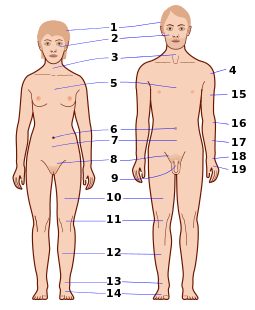pirksts
Latvian
| Picture dictionary | ||
|---|---|---|
| ||
|
Etymology
From Proto-Balto-Slavic *pirštas, from Proto-Indo-European *per (“over”) (whence also Latvian par, q.v.) in its reduced grade *pr̥, with *stā- (“to stand”) (whence also Latvian stāt (“to stop”), q.v.). The original meaning was therefore “(the one(s)) standing in front, directed to(ward) the front.” Cognates include Lithuanian pir̃štas, Old Prussian pīrsten (probably masculine accusative), nagepristis (“toe nails, claws”) (< *nagepirstis), Proto-Slavic *prьstъ (Russian archaic перст (perst), Ukrainian перст (perst), Upper Sorbian porst, Bulgarian пръст (prǎst), Czech prst, Polish parst), Old High German first (“spike, protuberance”), German First (“ridge, top”), Sanskrit पृष्ठम् (pṛṣṭhám, “back, tip, ending”), Avestan 𐬞𐬀𐬭𐬱𐬙𐬀 (paršta, “backbone, spine”), Latin postis (“post, doorpost”) (< *porstis “the one standing in front”).[1]
Pronunciation
Noun
pirksts m (1st declension)
- (anatomy) finger, toe (movable extremities of the hand or foot)
- slaidi, gari pirksti ― long, slender fingers
- līki pirksti ― crooked fingers
- pirksta locītava ― knuckle (lit. finger joint)
- pirksta kauli, gali ― finger bones, tips
- pirkstu nospiedums ― fingerprint
- lielais pirksts ― big toe
- rādītāja pirksts, rādītājpirksts ― index (lit. showing) finger
- vidējais pirksts ― middle finger
- skaitīt uz pirkstiem ― to count on one's fingers
- finger (parts of a glove that cover the fingers)
- noadīt cimda pirkstu ― to knit a glove finger
- elongated component or part of a mechanism
- virzuļa pirksts ― piston (connecting) rod
Declension
| singular (vienskaitlis) | plural (daudzskaitlis) | |
|---|---|---|
| nominative (nominatīvs) | pirksts | pirksti |
| accusative (akuzatīvs) | pirkstu | pirkstus |
| genitive (ģenitīvs) | pirksta | pirkstu |
| dative (datīvs) | pirkstam | pirkstiem |
| instrumental (instrumentālis) | pirkstu | pirkstiem |
| locative (lokatīvs) | pirkstā | pirkstos |
| vocative (vokatīvs) | pirksts | pirksti |
Derived terms
- pirksta locītava
- pirkstiņš
- virzuļa pirksts
References
- Karulis, Konstantīns (1992), “pirksts”, in Latviešu Etimoloģijas Vārdnīca (in Latvian), Rīga: AVOTS, →ISBN
.jpg)

